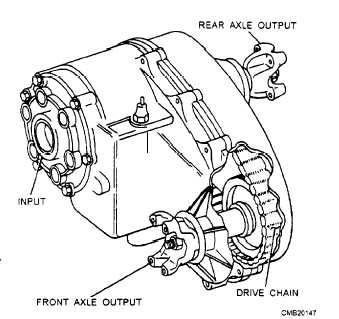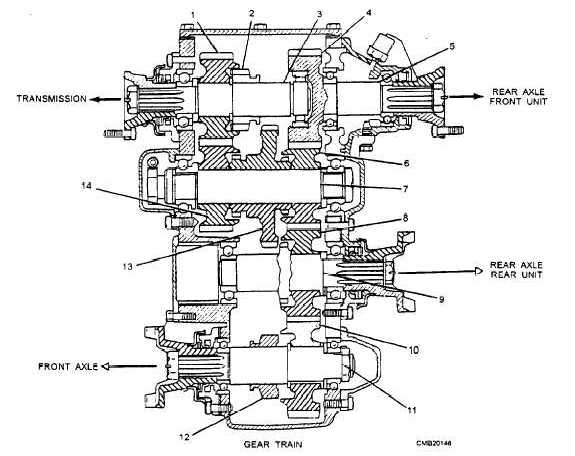Conventional transfer cases in heavier vehicles have two-speed positions and a de-clutching device for disconnecting the front-driving wheels. A cross section of a conventional two-speed transfer case is shown in figure 5-28. This type of transfer case is used for a six-wheel drive vehicle. Some light-duty vehicles use a chain to transmit torque to the front-driving axle (fig. 5-29).
The conventional transfer case provides a high and low final drive gear range in the same manner as an auxiliary transmission. In most cases, the shifting is accomplished through a sliding dog clutch, and shifting must be done while the vehicle is not moving. Typical operation of a conventional two-speed transfer case is as follows:
High Range (fig. 5-30) - When driving the front and rear axles in the high range (1:1 gear ratio), the external teeth of the sliding gear

Figure 5-29. - Typical conventional transfer case using chain drive.
1. MAINSHAFT CONSTANT MESH GEAR
2. MAINSHAFT SLIDING GEAR
3. MAINSHAFT
4. REAR AXLE (REAR UNIT) DRIVE GEAR
5. REAR AXLE (REAR UNIT) DRIVE GEAR ASSEMBLY
6. IDLER SHAFT CONSTANT MESH GEAR
7. IDLER SHAFT
8. DRIVE SHAFT CONSTANT MESH GEAR
9. REAR AXLE (FRONT UNIT) DRIVE SHAFT
10. DRIVE SHAFT CONSTANT MESH GEAR
11. FRONT AXLE DRIVE SHAFT
12. DRIVE SHAFT SLIDING GEAR
13. IDLER SHAFT LOW SPEED GEAR
14. IDLER SHAFT CONSTANT MESH GEAR

Figure 5-28. - Cross-section of a typical conventional transfer case.
Continue Reading